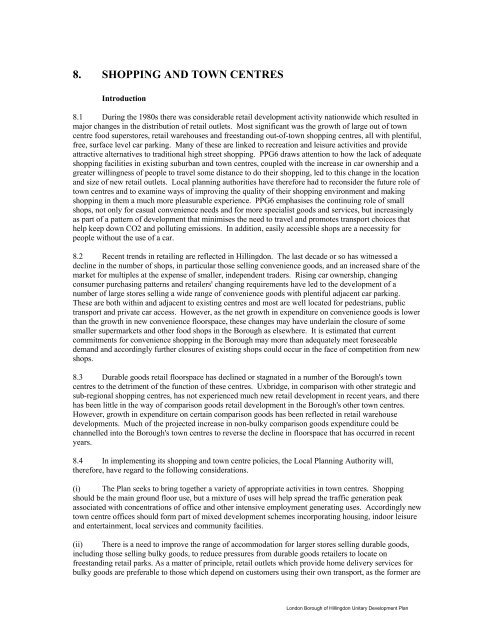HILLINGDON UNITARY DEVELOPMENT PLAN - London Borough ...
HILLINGDON UNITARY DEVELOPMENT PLAN - London Borough ...
HILLINGDON UNITARY DEVELOPMENT PLAN - London Borough ...
You also want an ePaper? Increase the reach of your titles
YUMPU automatically turns print PDFs into web optimized ePapers that Google loves.
8. SHOPPING AND TOWN CENTRES<br />
Introduction<br />
8.1 During the 1980s there was considerable retail development activity nationwide which resulted in<br />
major changes in the distribution of retail outlets. Most significant was the growth of large out of town<br />
centre food superstores, retail warehouses and freestanding out-of-town shopping centres, all with plentiful,<br />
free, surface level car parking. Many of these are linked to recreation and leisure activities and provide<br />
attractive alternatives to traditional high street shopping. PPG6 draws attention to how the lack of adequate<br />
shopping facilities in existing suburban and town centres, coupled with the increase in car ownership and a<br />
greater willingness of people to travel some distance to do their shopping, led to this change in the location<br />
and size of new retail outlets. Local planning authorities have therefore had to reconsider the future role of<br />
town centres and to examine ways of improving the quality of their shopping environment and making<br />
shopping in them a much more pleasurable experience. PPG6 emphasises the continuing role of small<br />
shops, not only for casual convenience needs and for more specialist goods and services, but increasingly<br />
as part of a pattern of development that minimises the need to travel and promotes transport choices that<br />
help keep down CO2 and polluting emissions. In addition, easily accessible shops are a necessity for<br />
people without the use of a car.<br />
8.2 Recent trends in retailing are reflected in Hillingdon. The last decade or so has witnessed a<br />
decline in the number of shops, in particular those selling convenience goods, and an increased share of the<br />
market for multiples at the expense of smaller, independent traders. Rising car ownership, changing<br />
consumer purchasing patterns and retailers' changing requirements have led to the development of a<br />
number of large stores selling a wide range of convenience goods with plentiful adjacent car parking.<br />
These are both within and adjacent to existing centres and most are well located for pedestrians, public<br />
transport and private car access. However, as the net growth in expenditure on convenience goods is lower<br />
than the growth in new convenience floorspace, these changes may have underlain the closure of some<br />
smaller supermarkets and other food shops in the <strong>Borough</strong> as elsewhere. It is estimated that current<br />
commitments for convenience shopping in the <strong>Borough</strong> may more than adequately meet foreseeable<br />
demand and accordingly further closures of existing shops could occur in the face of competition from new<br />
shops.<br />
8.3 Durable goods retail floorspace has declined or stagnated in a number of the <strong>Borough</strong>'s town<br />
centres to the detriment of the function of these centres. Uxbridge, in comparison with other strategic and<br />
sub-regional shopping centres, has not experienced much new retail development in recent years, and there<br />
has been little in the way of comparison goods retail development in the <strong>Borough</strong>'s other town centres.<br />
However, growth in expenditure on certain comparison goods has been reflected in retail warehouse<br />
developments. Much of the projected increase in non-bulky comparison goods expenditure could be<br />
channelled into the <strong>Borough</strong>'s town centres to reverse the decline in floorspace that has occurred in recent<br />
years.<br />
8.4 In implementing its shopping and town centre policies, the Local Planning Authority will,<br />
therefore, have regard to the following considerations.<br />
(i) The Plan seeks to bring together a variety of appropriate activities in town centres. Shopping<br />
should be the main ground floor use, but a mixture of uses will help spread the traffic generation peak<br />
associated with concentrations of office and other intensive employment generating uses. Accordingly new<br />
town centre offices should form part of mixed development schemes incorporating housing, indoor leisure<br />
and entertainment, local services and community facilities.<br />
(ii) There is a need to improve the range of accommodation for larger stores selling durable goods,<br />
including those selling bulky goods, to reduce pressures from durable goods retailers to locate on<br />
freestanding retail parks. As a matter of principle, retail outlets which provide home delivery services for<br />
bulky goods are preferable to those which depend on customers using their own transport, as the former are<br />
<strong>London</strong> <strong>Borough</strong> of Hillingdon Unitary Development Plan
















